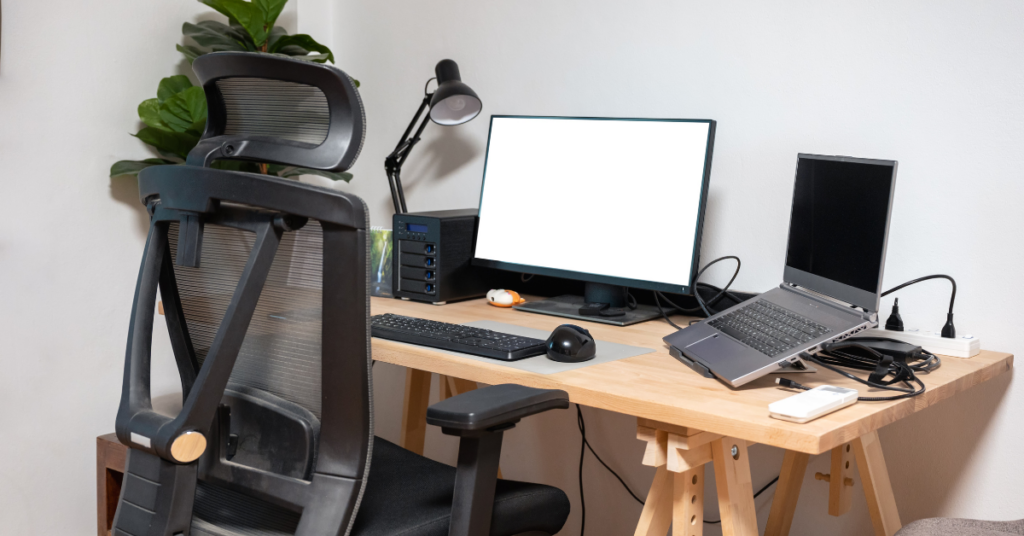Ergonomic Practices for Home Offices in Cloverdale, BC

With the rise of remote work, many residents in Cloverdale, BC, are setting up home offices. While working from home offers flexibility, it also presents challenges, particularly in maintaining proper ergonomics. Poor ergonomics can lead to discomfort, reduced productivity, and long-term health issues. This article explores essential ergonomic practices to help Cloverdale residents create a comfortable and efficient home office environment.
1. Choosing the Right Chair
A good ergonomic chair is the cornerstone of a comfortable home office. It should provide adequate support for the lower back, promote good posture, and reduce strain on the body. To further enhance your home office ergonomics, consider incorporating these posture-boosting tips to ensure you maintain a strong and healthy alignment throughout your workday.
Key Features:
- Adjustable Height: Ensure your feet rest flat on the floor, and your knees are at a 90-degree angle.
- Lumbar Support: Look for chairs with adjustable lumbar support to maintain the natural curve of your spine.
- Armrests: Adjustable armrests help reduce shoulder and neck strain.
2. Optimal Desk Setup

The desk should accommodate all your work essentials while promoting a neutral body posture. The height and layout of your desk play crucial roles in preventing strain.
Tips for Desk Setup:
- Height: The desk height should allow your forearms to be parallel to the ground or slightly angled downwards.
- Space: Ensure there’s enough space under the desk for your legs to move freely.
- Organization: Keep frequently used items within easy reach to avoid unnecessary stretching or twisting.
3. Monitor Placement
Proper monitor placement is critical to reducing eye strain and neck pain. The position of your monitor can significantly impact your comfort levels.
Guidelines:
- Height: The top of the monitor should be at or slightly below eye level.
- Distance: Position the monitor about an arm’s length away from your eyes.
- Alignment: Keep the monitor directly in front of you to avoid neck twisting.
4. Keyboard and Mouse Positioning

The positioning of your keyboard and mouse should allow for a natural wrist and arm posture to
prevent repetitive strain injuries.
Best Practices:
- Keyboard: Keep the keyboard at a height where your wrists are straight, and your hands are at or slightly below elbow level.
- Mouse: Place the mouse close to the keyboard and at the same level to avoid overreaching.
- Wrist Support: Consider using a wrist rest to maintain a neutral wrist position.
Preventing carpal tunnel syndrome is crucial when working long hours at a desk. Incorporating specific exercises can help manage and prevent symptoms.
5. Lighting and Screen Glare
Proper lighting can prevent eye strain and headaches. Both natural and artificial lighting should be considered when setting up your home office.
Lighting Tips:
- Natural Light: Position your desk near a window but avoid direct sunlight on your screen.
- Artificial Light: Use adjustable desk lamps to provide focused lighting without creating glare on your monitor.
- Screen Glare: Reduce glare by using anti-glare screen protectors or adjusting the monitor angle and brightness.
6. Breaks and Movement

Regular breaks and movement are essential to counteract the sedentary nature of desk work. Incorporate short breaks and exercises into your daily routine. If you’re experiencing discomfort despite following ergonomic best practices, visiting a chiropractor can offer targeted relief and help address any underlying issues caused by poor posture or repetitive strain.
Strategies:
- Microbreaks: Take a 1-2 minute break every 20-30 minutes to stretch and move around.
- Exercise: Incorporate exercises such as neck stretches, shoulder rolls, and wrist stretches to alleviate tension.
- Standing: Consider using a sit-stand desk to alternate between sitting and standing throughout the day.
7. Foot Support
Proper foot support can improve overall posture and reduce strain on your lower back and legs. For persistent back pain that doesn’t improve with ergonomic adjustments, exploring local options for back pain relief can provide additional support and healing.
Foot Support Tips:
- Footrests: If your feet don’t rest flat on the floor, use a footrest to provide support.
- Flat Feet: Ensure your feet are flat on the floor or footrest, with your ankles at a 90-degree angle.
8. Telephone and Headset Use
For those who spend a significant amount of time on the phone, using a headset can prevent neck and shoulder strain.
Recommendations:
- Headsets: Use a headset instead of cradling the phone between your shoulder and ear.
- Speakerphone: Utilize the speakerphone feature during longer calls.
Conclusion
Creating an ergonomic home office in Cloverdale, BC, is essential for maintaining comfort, productivity, and long-term health. For those dealing with chronic pain related to their home office setup, acupuncture offers a holistic approach to pain relief and overall wellness. By implementing these ergonomic practices, residents can reduce the risk of discomfort and injury associated with prolonged desk work. Investing in proper equipment and developing healthy work habits can lead to a more enjoyable and sustainable remote work experience.
If you’re experiencing any discomfort or pain despite implementing these ergonomic practices in your home office, it may be time to seek professional help. If you’re looking for Cloverdale chiropractic services, our team at Clover Hills Rehabilitation can provide targeted treatments to address your specific needs, helping you maintain optimal health and productivity. Don’t let pain disrupt your work-from-home experience—contact us today to schedule an appointment.
